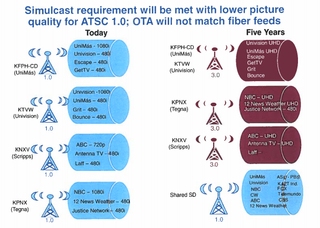Charter Doubtful About Future of ATSC 3.0
WASHINGTON—The future of Next Gen TV could be imperiled by a lack of standards for MVPDs, lack of backward compatibility and the fact that the potential services offered by ATSC 3.0 are already available via IP—or a combination of all three.
These warnings were issued by several executives from Charter Communications, the nation’s third largest cable operator, which met with FCC officials late last month. The FCC has adopted rules that require those broadcasters moving to ATSC 3.0 to simulcast an ATSC 1.0 signal for at least the next five years.
Although broadcasters are just beginning to roll out ATSC 3.0 services, there has been no standard developed to make such signals compatible with current cable equipment, Charter told the FCC.
“The absence of such standards could delay the ATSC 3.0 transition by years for consumers who do not get their broadcast signals over the air,” Charter said in an ex parte letter to the FCC, adding that according to a recent NAB report, “ATSC 3.0 has over 40,000 possible configurations.”
Charter also complained that despite the benefits viewers could see from ATSC 3.0, “broadcasters have yet to define which among those possible uses of the new standard they are interested in pursuing,” adding that many of the benefits of ATSC 3.0 are already available via IP, “which could limit demand for ATSC 3.0 consumer equipment.”
Charter also told the FCC that the ATSC 1.0 signals in the Phoenix Model Market test site are different from the ATSC 1.0 signals delivered by fiber and provided charts for illustration. “Because these signals don’t match, there is currently no back-up for ATSC 1.0 that can be utilized by MVPDs,” the cable operator said.
The following is a response from Madeleine Noland, president of ATSC, posted Aug. 10:
Get the TV Tech Newsletter
The professional video industry's #1 source for news, trends and product and tech information. Sign up below.
“ATSC respects Charter’s role as a leading MPVD, and we look forward to working with them to address their concerns, many of which are unfounded. Our ATSC 3 MPVD work continues apace, especially within the ATSC S37 specialist group. S37 was formed in 2015 and Charter has been welcomed as a guest member for the past three years.
We wish to reassure Charter and the Commission that the ATSC S37 specialist group is actively communicating with SCTE to forge a path forward for cable customers to enjoy key Next Gen TV features. We also wish to extend our thanks to broadcast leaders who are working closely with their MVPD partners as they prepare to launch ATSC 3 services.”


For a comprehensive source of TV Technology’s ATSC 3.0 coverage, see ourATSC3 silo.
Tom has covered the broadcast technology market for the past 25 years, including three years handling member communications for the National Association of Broadcasters followed by a year as editor of Video Technology News and DTV Business executive newsletters for Phillips Publishing. In 1999 he launched digitalbroadcasting.com for internet B2B portal Verticalnet. He is also a charter member of the CTA's Academy of Digital TV Pioneers. Since 2001, he has been editor-in-chief of TV Tech (www.tvtech.com), the leading source of news and information on broadcast and related media technology and is a frequent contributor and moderator to the brand’s Tech Leadership events.

